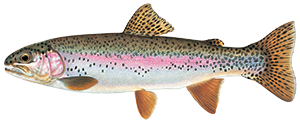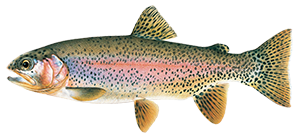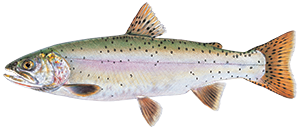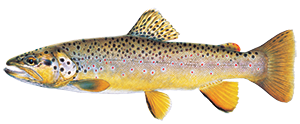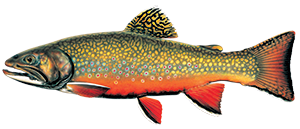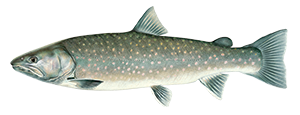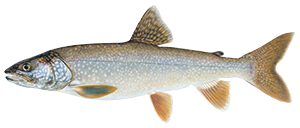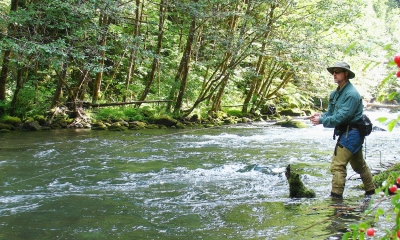
Oregon's trout species
Trout are Oregon's most popular game fish but there are several species and not all are open to fishing. Learn how to identify them correctly, and find some tips for catching them too.

Oregon is home to several trout species, both native species and those that were introduced decades ago and are now reproducing naturally.
Rainbow trout
The most widely stocked and distributed trout in Oregon. They occur naturally in many rivers and streams, and each year ODFW stocks millions more in ponds, lakes and streams. They have a well-earned reputation for being a hardy, hard-fighting game fish.
Highly variable in color, often silvery, with light pink to red stripes along their sides. They can get up to 30 inches long and prefer cold, clear water.
Their diet consists of minnows, crayfish, insects and other small aquatic life, making them susceptible to a well-presented spinner, flatfish or fly. Baits, such as night crawlers and dough bait (like PowerBait), can also be very effective.
Redband trout
A subspecies of native rainbow trout that have adapted to the arid, desert conditions of eastern Oregon. Chances are, if you catch a native (not stocked) rainbow trout in a river east of the Cascades, it’s a redband.
As the name suggests, these fish have rosy red strip along their sides. Other identification clues include large, profuse black spots on the body and orange and yellow tints along the belly.
Few waters with native redband populations allow the use of bait. Anglers often catch them with artificial flies and lures.
Lahontan cutthroat trout
This variety has adapted to dry, highly alkaline conditions and was once widespread throughout the Lahontan Basin of California, Nevada and southeast Oregon. Today, native populations can be found in the Whitehorse and Willow creek basins that are so far southeast in Oregon they’re practically in Nevada.
These fish feed primarily on smaller fish, so flies and lures that mimic minnows work well.
Coastal cutthroat trout
These trout get their name from the red-orange slashes on the underside of the lower jaw. The most common variety in Oregon is the coastal cutthroat found in the streams and beaver ponds in coastal drainages. They also are stocked in high mountain hike-in lakes where the water stays cool throughout the summer.
Coastal cutthroat trout are heavily spotted – even on the belly. The profusion of black spots and the red-orange slashes on the jaw help distinguish them from rainbow trout.
Cutthroats that are year-round residents of small streams may not get any bigger than 8-9 inches, but can reward the angler with an aggressive bite and enthusiastic fight.
Bait is not generally allowed on coastal streams above tidewater, but these feisty fish respond well to spinners, flies and other artificial lures.
Sea-run cutthroat trout
This is a sea-run strain of the coastal cutthroat that travels into the saltwater estuaries for a few months of the year. Unlike salmon and steelhead, sea-run trout don’t migrate far from their home river and return to freshwater in late summer – July and August.
While in the sea, sea-run cutthroat feed on crustaceans and small fish, growing up to one inch a month. By the time they return to fresh water to spawn, they can be up to 18 inches long and are bright silver, much like a small steelhead.
Sea-run cutthroat trout are more predatory than their resident cousins and anglers often target them with lures and flies that mimic small fish.
Brown Trout
These nonnative trout, introduced in the U.S. in 1883, have a reputation for being wily and elusive. While they prefer cold spring-fed rivers and streams, and lakes with cold water inlets, brown trout also can tolerate warmer waters.
Brown trout can be readily distinguished from rainbow and cutthroat trout by the absence of spots on the tail. Elsewhere on the body, there are both black and red spots with a pale halo. Size can range from 11 inches in small streams to over 30 inches in large rivers or lakes.
While brown trout have a varied diet, anglers targeting them often use spinners or flies that mimic minnows.
Fish we call trout but that are actually char
Char are in a different genus than are trout, but they often inhabit the same waters as trout and are often fish in similar manners. In fact, they are often referred to as “trout.” Char differ from trout in many ways, but two most relevant to anglers are:
- Char have red, pinkish, orange or light yellow spots compared to the trout’s black spots.
- Char prefer and are adapted to colder water than most trout.
Brook trout
An introduced species first stocked in the early 1900s and widely distributed from high mountain lakes to headwater tributaries. They are the most prevalent game fish in wilderness and non-wilderness high lakes.
Brook trout are easily identified by the worm-like pale yellow markings on the back, additional red dots with blue halos and white borders on the lower fins. In small streams brook trout are often 5 to 7 inches long but can reach 25 inches or more in large rivers or lakes.
Because insect larvae and nymphs make up a large part of their diet (especially when fish are small), they are a favorite of fly fishers who use flies mimicking these insects. However, these aggressive biters also go after a variety of bait and lures.
Bull trout
In Oregon the bull trout is listed as a threatened species, and there are very few places where anglers can actively target them. However, anglers often can encounter a bull trout when fishing for other species. Oregon fishing regulations call for most bull trout to be release unharmed, so knowing how to identify them is important.
While their coloration can be variable, they are generally gray infused with green. The body is covered with small white or pale yellow spots, and there may some pink or red spots intermingled. The lower fins are often orange or reddish.
Anglers can fish specifically for bull trout in the Metolius River and the Metolius arm of Lake Billy Chinook. The fish are voracious predators of other fish, so anglers often use lures or flies mimicking large minnows or small fish.
Lake trout
These aggressive, fish-eating char are popular sport fish found in deep, cold-water lakes. Sometimes called mackinaw, they have a loyal following among anglers who appreciate the way they attack a lure and fight hard once hooked.
The lake trout is not particularly colorful – usually gray with large pale spots – and can be further distinguished from other trout with its deeply-forked tail.
Many anglers target lake trout in the spring, when they hang out closer to the surface. As the summer progresses and the surface waters heat up, lake trout will move into the deepest parts of the lake looking for cooler water.

